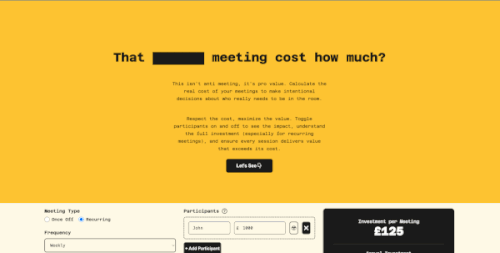Who Really Needs to Be in the Room?
TL;DR: Keep your team and clients informed, involve the right people at the right time, and build trust to boost autonomy and collaboration. Real meetings cost real money, That ███████ meeting cost cost how much calculator helps visualize this so you can make smarter decisions about who really needs to be in the room.
When kicking off a project, the best thing you can do is make sure everyone, your team and your client, is genuinely in the loop. Being sure to have the right people involved from the start and keeping people informed closes communication gaps, builds trust, and gives teams the autonomy to deliver great work. That's how you face tough technical problems head-on and avoid unnecessary confusion.
It All Starts with Who’s in the Room
A key part of this philosophy is getting the right people involved at the right time. Effective collaboration beats silos every time. Project velocity almost always improves when cross-functional voices are present from day one. For example, on a design-led project, I'll always push for a technical team member to join from the first client workshop. Similarly, on tech-led projects, design or UX voices should be part of early conversations to ensure a balanced mix of perspectives - a balance that in the long run saves time and money.
It's surprising how often people over or underestimate the value or complexity of something outside their own discipline. That's how time sinks creep into scope or valuable ideas get missed. While this specific example is relevant in a digital model, the principle applies universally to any business: involve diverse expertise early, and everyone benefits.
Empower, Don’t Overcrowd
Building trust, both within your team and with clients, drives confidence and encourages team members to take on more ownership and communicate honestly and openly. When you empower your team, you reduce the need for top-heavy meetings where senior leaders are present just for visibility. This, in turn, helps avoid the HiPPO takeover 🦛 (Highest Paid Person's Opinion) problem, ensuring the people closest to the work have the appropriate equity to lead conversation.
Sure, this can feel unfamiliar to legacy organizations used to trickle-down structures. But it consistently delivers value, not just financially, but also in terms of team growth and clarity of vision.
Clarity is the simplest investment
Clear ownership and preparation are just as important as attendance. A well defined agenda, shared upfront if possible, prevents meetings from drifting and helps teams focus faster. If we can shave even five or ten minutes off each call by skipping the "so, what are we talking about today?" moment, that time compounds fast, clarity is one of the simplest forms of cost-saving.
Time is our most precious commodity; Especially in any organization with highly paid, highly skilled specialists, every minute spent in a low-value meeting is money and focus walking out the door. The aim isn't to create anxiety around meetings but to promote intentionality. If a 30-minute sync costs the business £500, we should be asking: are we getting £501 of value (or more) from this discussion? If not, it's time to reassess: are the right people in the room?
Break that down to the data
To help illustrate this viewpoint (and to satisfy my own tinkering curiosity), I have built "That ███████ meeting cost cost how much" to visualize the cost of a meeting. It's not anti-meeting; It's pro-value. When a meeting costs £X, the real question becomes: how do we ensure it's worth it? The goal is to encourage intentionality, making sure time is invested where it drives outcomes.
That's exactly what my calculator helps with. It shifts the conversation from vague complaints about too many meetings to a quantifiable decision about participation. The tool is completely free, runs entirely client-side (so it stores nothing), and promotes radical transparency. By inputting hourly rates and meeting duration, teams can instantly see how much a session really costs, especially when recurring weekly calls add up. You can toggle participants on and off to see immediate savings and make informed decisions about who truly needs to attend.
So before sending that next calendar invite, take a moment to run the numbers. Calculate the cost, look at the annual impact, and critically assess whether everyone invited is essential to achieving the goal. Use the data to challenge the default, reduce reliance on the HiPPO, and give time back to your specialists. Don't fear the meeting, respect the cost. Only then can your collaborations deliver value that truly exceeds the investment.
Have a think, have a lovely day, and please use the great power of the tool responsibly.
If the money you've saved by optimising your meetings for the right people is starting to burn a hole in your pocket, and you're looking to tackle bigger technical challenges, feel free to reach out. I'm always up for a good chat about making work (and tech) work better.

